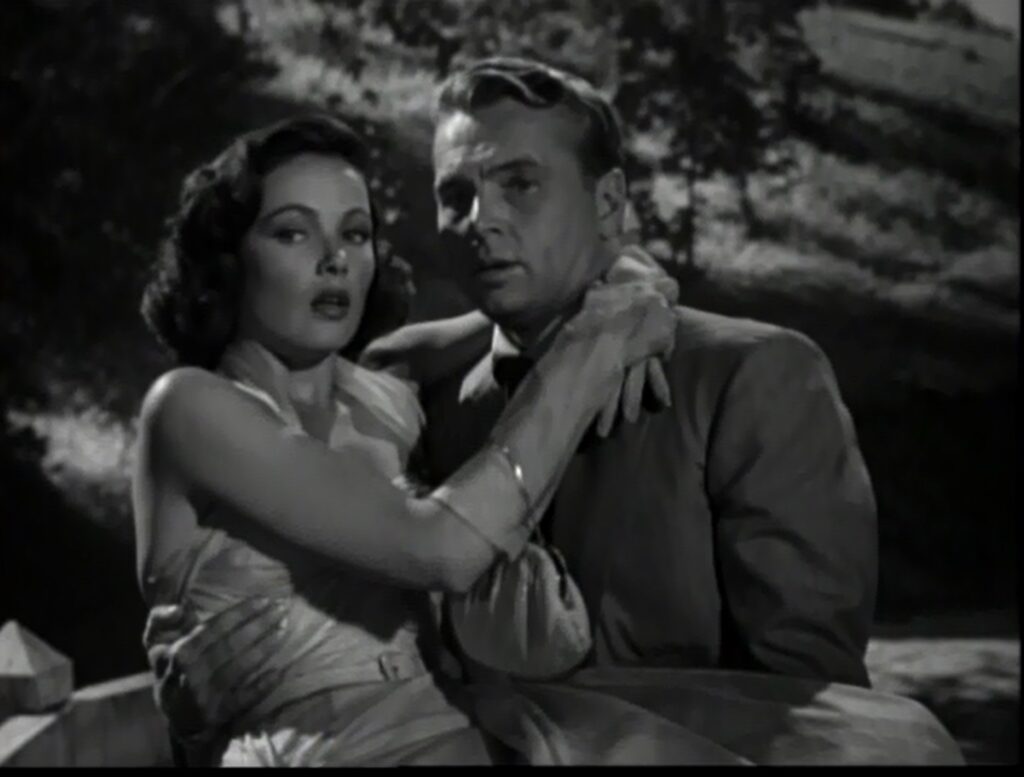The freedom of women and mothers as cardinal subjects
«The Mating Season»

The return to luminous comedy
When it was said —and it is often maintained today by his scholars— that Mitchell Leisen had entered a phase of decadence, a surprise arose. He filmed a delightful film[1]. By the way, it was not very aptly titled The Mating Season —something like “the time of love”, at best—. For once it was much better adapted into Spanish as “Married and with two mothers-in-law”. It was 1951 and after his recent conversion of film noir into personalist cinema in “No Man of Her Own” (“Latent Lie”)[2], our director gives us a kind and luminous film, which once again portrays women free to approach their motherhood, showing how they can do it in two very different ways.
In the script, he counted on the master Charles Brackett (1892-1969). It was their last mutual collaboration. The writer had just finished his last work with Billy Wilder on Sunset Blvd. (Billy Wilder, 1950). A cult film, but also with undeniable bitter overtones. In The Mating Season, Walter Reisch (1903-1983) and Richard L. Breen (1918-1967) also appear credited as screenwriters.
Perhaps Leisen and Brackett agreed on wanting to return to those film landscapes where the beauty of what is offered on the screen comes from the human quality of the characters that are perceived in this way by the spectator. Both, especially the director, were masters at achieving this tone of cinematic communication. They set to work and in our opinion, it is clear that they succeeded. They were aware that in cinema there is often a call to repetition, which is extremely constructive. As happens in life, some films function as repeated invitations to return to good memories, to enjoy them, and the existential security they provide us.
A philosophy of motherhood with all its range of nuances
And one of those ennobling themes that Leisen liked to revisit has to do, we insist, with focusing his consideration on women to narrate with the camera the freedom and love in the story of some mothers. We have synthetically presented the keys to this film work by Leisen elsewhere[3] in what we have designated as his philosophy of motherhood, with all its range of nuances.
Now we want to ask ourselves again about what Leisen wanted to propose by presenting certain women who, in the exercise of their freedom, are singularly creative in living their motherhood as a project and commitment. And we do so with a word that we have already let slip in the first lines of this writing: surprise. Why? Because, as we have already pointed out, we believe that it was not expected that Leisen and Brackett could make such an endearing film after having had such recent successes exploring the shadows or declared obscurities of the human condition. And perhaps for this reason it is not very predictable that they would turn precisely at that time to a resource so typical of everyday life as what is exposed in this comedy.
And we turn, as is typical of our personal way of analyzing cinema, to a philosophical writing that helps us better understand what we see on the screen. The appearance in 2023 of the translation into Spanish of the work of the French phenomenologist Natalie Depraz (1964), Le sujet de la surprise: Un sujet cordial — Phenomenology of surprise: a cordial subject (Depraz, 2023) — has allowed us to reflect on a subject rarely considered by philosophical treatises or even by film studies. But we believe that it is essential when it comes to considering the relationship between bioethics and cinema, because of all that it reveals about the human condition, in its most sensitive fibers.
A narrative is altered in its rhythm by the continuous appearance of surprises
Let us describe the plot of the film in this way as “a concatenation of surprises.” We can also think that it is an almost indispensable resource so that a topic already addressed on successive occasions by Leisen—the freedom of women in the face of motherhood—is at the same time new for the spectator and for the scholar. A paradoxical resource, completely effective.
In The Mating Season, the narrative is disrupted by the constant appearance of surprises. Let’s see: it starts with a woman, Ellen McNulty (Thelma Ritter), who has to leave her business and her town because she can’t afford the bank loan; her son, Val McNulty (Joseph Lund), who works in another city, working hard, even at night, to get promoted in the company where he is employed, is sent by his drunk boss, George G Kaliner Jr. (James Lorimer) to rescue the young woman who has rejected him and who is in a bind; when he finds her, whose name is Maggie Carleton (Gene Tierny), he sees that she is with her car on the edge of a cliff, about to fall; he carefully rescues her – the car, of course, immediately falls off the cliff – he takes her in his arms, they look at each other, they are struck by love and without thinking much they decide to get married.
From there, the biggest surprise and the central resource of the film will arise. While preparing the reception of the guests to celebrate her wedding in the apartment that Val has rented, Maggie takes Ellen, her mother-in-law, for someone that the employment agency has sent to help her. She is, as we know, a humble and hard-working woman, who contrasts with the elitist and refined environment in which the young woman has been raised. Ellen McNulty will maintain the misunderstanding in order to be close to her son without creating financial problems for him, accepting the job as a cook that they offer her. Everything will become complicated when Maggie’s mother, Fran Carleton (Mirian Hopkins), unexpectedly appears with the intention of staying in the small apartment of the young couple.
With clarity, Leisen exposes two radically different ways of approaching motherhood, through two women who are widowed. Ellen McNulty makes an exercise of self-denial in order not to interfere in the development of the recently contracted marital community. Fran Carleton, on the other hand, cannot stand the fact that her daughter has married a “nobody” and will do everything she can to confront the couple, to try to break them up. She begins by demanding that she be the one to share the bedroom with her daughter, sending Val to the living room sofa, before Ellen’s astonished gaze.
The situation reaches its highest tension when Fran secretly surprises her son-in-law with an affectionate conversation with Ellen, which leads him to maliciously think of infidelity. When she is telling her daughter, some of Ellen’s friends appear asking for her as Mrs. McNulty, which brings to light the strange situation that has occurred. Maggie finds it unbearable that her husband has hidden her from her mother in this way. She attributes it to the fact that he has done it to advance professionally, and this causes a deep crisis in the newlyweds, because she was not looking for social standing in her husband, but authenticity.
“All the stray dogs in town wanted him; that’s the test”
Leisen and Brackett will prepare a solution to the conflict that is completely out of the predictable. They will introduce a providential character, Mr. Kaliner Sr. (Larry Keating). Completely fed up with his son’s spoiled and capricious airs, he will take Maggie and Val’s side in a decisive manner. And not only that. He will meet Ellen McNulty, first as a simple servant, and then he will begin to profess a devoted admiration for her. He will see in her the practical woman who knows how to save his suit from the clumsiness of his son who has made a piece of cake fall on it, using a knife instead of a rag. Also, on loan from Maggie and Val, she comes to serve him when Mr. Kaliner Sr. is sick, applying effective home remedies.
It is especially at this moment that he hears her story as a widow who sincerely loved her husband, despite his many weaknesses. The businessman asks her if he was a good guy, and she gives an answer that refers to the values of the heart: “all the stray dogs in the city loved him; that is the test”[4]. And when he insists on asking her if she loved him, she tells him that he can bet on it. The businessman, accustomed to an artificial social world, begins to like what the most authentic way of life of simple people conveys.
Finally, Val will recognize that her Maggie is right and that there is no professional position that justifies hiding who her mother is for even a second, much less being ashamed of her. Leisen and Brackett confirm this in a masterful final scene, in which Ellen McNulty walks happily down the street, after seeing her son reconciled with Maggie, and now proud of her, his mother. With an umbrella she holds out the rain. She stops a car that invites her to get in. It’s Mr. Kaliner Sr. She resists because she says she’s soaked and will give her the car as a lost item. The millionaire insists. Ellen agrees and as the car starts, the marriage proposal couldn’t be more eloquent, coming from a man of his position: “stray dogs like me too.”
Surprises turn us into unpretentious subjects, always open.
Natalie Depraz rightly states that… surprises turn us into unpretentious subjects, always open, subjects who take the risk of not knowing, the risk of getting lost, of being deprived of our security, of collapsing in our most intimate center, petrified; stunned, galvanized, it depends. The surprise, small or large, confronts me with the incomprehensible and imposes on me the absence of meaning, even if it means rapture, vertigo, despair. (Depraz 2023: 27).
And she adds in a somewhat provocative tone: “the surprising thing is that surprise is not a philosophical concept. This is, perhaps, the most beautiful surprise” (Ibidem). Later on, she persuasively indicates the effect that this type of experience has on us.
Surprise makes us leave ourselves. And as a result, it forces us to confront otherness. The other, of course, but also that other in Us, who is our most intimate other and whom we often know very little about. (Depraz, 2023: 33)
The Mating Season provides good examples of this. Ellen, her son and her husband, and Mr. Kalinger Sr. all follow that path that makes them leave themselves (Ellen leaves her business, changes cities; Val has to accept her modest origins; Maggie abandons her sheltered life; the businessman lets himself be looked after by someone humble…) that allows them to better recognise the other and themselves.
Instead of the sole body-brain interaction, I propose the body-heart-brain interaction
The most relevant aspect of the theory of surprise and its emotional impact that Depraz constructs is that it is an epistemological proposal that changes our way of relating fundamental anthropological categories.
Instead of the sole body-brain interaction, I propose a more articulated integral framework, structured by the body-heart-brain interaction. The inclusion of the heart has the advantage of explicitly naming the emotional pole, which is simultaneously linked to the body, on the one hand (the cardiovascular rhythm of the muscle pump) and to the brain, on the other (the areas of the hippocampus and the amygdala, known to be the brain areas of emotion) (Depraz 2023: 109)
His proposal is to move from “neurophenomenology” to “cardiophenomenology” to the extent that the latter proposes a purpose.
The task of linking the cardiovascular component (third person) and the emotional component (first person), these two aspects, experimental and experiential, being the two sides of the same continuous, preconscious fold, where the heart clearly operates (Depraz 2023: 110)
The heart does not initially depend on brain stimuli.
From the solid practical and theoretical argument with which Depraz supports his cardiophenomenology, we are particularly interested in what he designates as “the embryo-genetic argument with ontological meaning”, that is, the heart system, the driving force of the organism’s growth:
… if the brain controls the body, it consequently controls the heart organ of the body, because otherwise, the heart would be an organ, a unique organ that would have exceptional autonomy. But it is known that spontaneous cardiac contractions during the first three weeks of the embryo’s life take place autonomously, before any cerebral nervous reaction. Unlike other organs, the heart does not begin to function during these first weeks by reacting to stimuli from the nervous system: it is born and self-organizes independently of the brain, even before the latter is functional. Therefore, the heart does not initially depend on brain stimuli. Brain control only comes into play later, after several months of life. There is therefore a “preneural dynamic” in life that gives the heart primacy and centrality in organic growth, and to which the brain will later ally itself. (Depraz 2023: 127)
Furthermore, this argument allows us to understand that
… the heart plays a methodological role: from the preconscious organic physiology of the cardiac muscle that irrigates the body of the organism, an affectivity emerges that remains, however, irreducible, as experience is to bodily sensations. (Depraz 2023: 129)
Cinema constitutes another laboratory for working on surprise and on the heart.
Thus, the French phenomenologist concludes.
Surprise resides in this affective-organic dimension, immediate and everyday for each subject and a variable
easy to produce and measure in the laboratory. As such, it represents the role of the heart. It mobilizes in an exemplary way the cardiac-affective fold of the heart, and offers a concrete place of experience for a subject that from now on I call “cardial”. (Depraz 2023: 130)
Cinema undoubtedly constitutes another sui generis laboratory to work on surprise, and with it on the heart. At least certain cinema that puts itself at the service of adequately describing human dignity (filmic personalism). And very particularly Leisen’s cinema when it focuses on the beauty of motherhood, as we see in The Mating Season. In it, the woman and mother as a cardial subject appears almost transparently. In addition, the surprises that the characters experience on the screen train us for those others that life has in store for us. Watching Ellen McNulty fighting for the son she has had to care for alone since she lost her husband allows us to recognize the inescapable truth that accompanies human procreation.
Conclusion
As pointed out by Dr. Carola Minguet Civera, a journalist:
Every child is a gift and a sacrifice. A present and a cross. And their education is an exciting but suffering mission. The baby who enchants and captivates, who longs for and needs his parents so much, will not only fall ill, have problems, give them trouble… but will grow up and make it clear to them that he does not belong to them, as we all have done.[5]
It is not only our society, which is becoming more confused on these essential issues every day, that needs to return to these truths. We believe that it is also each person as a free (and cardial) subject. And those of us who want to cultivate bioethics do not escape this. Good cinema comes to our aid so that we can see and consider again what we should never forget: we are cardial subjects who, if there has been no technological interference, have grown up under the heart of a mother, as John Paul II liked to point out. Therein lies our true home that leads us to live according to love. There are new and repeated homes that free women continue to build with their hearts and their will, and with the commitment of a husband and father who gives himself completely to that gift and that vocation. To that incomparable joy and surprise.
José Alfredo Peris-Cancio – Professor and researcher in Philosophy and Cinema – Member of the Bioethics Observatory – Catholic University of Valencia
***
[1] Accessible on YouTube: https://www.youtube.com/watch?v=2Vn4GWhc7es
[2] We have analyzed it in the previous contribution The struggle for the acceptance of life and for the family in «No Man of Her Own»: https://buff.ly/3yaQFQ7
[3] Peris-Cancio, J.-A. (2017). The philosophy of motherhood in Mitchell Leisen’s filmography. In J. Ibáñez-Martín, & J. Fuentes, Education and capabilities: towards a new approach to human development (pp. 289-305). Madrid: Dykinson.
[4] On this way of presenting the relationship with animals, you can consult this same page on bioethics and cinema, “Life is like this, and its contribution to bioethics”: https://buff.ly/3yaQPab
[5] Carola Minguet Civera, “Sustainable genealogy”: https://www.sotodelamarina.es/2024/01/Q1/20240109Carola_Minguet.htm
Related

Dance: Strength, Delicacy, and Dignity
Mar Dorrio
29 April, 2025
2 min

The Four Seasons of Your Life: Much More Than Music
P Angel Espinosa de los Monteros
28 April, 2025
3 min

A Pope Never Goes Away
José Antonio Varela
28 April, 2025
4 min

Divine Mercy, the Small and the Great
José María Montiu de Nuix
27 April, 2025
5 min
 (EN)
(EN)
 (ES)
(ES)
 (IT)
(IT)

